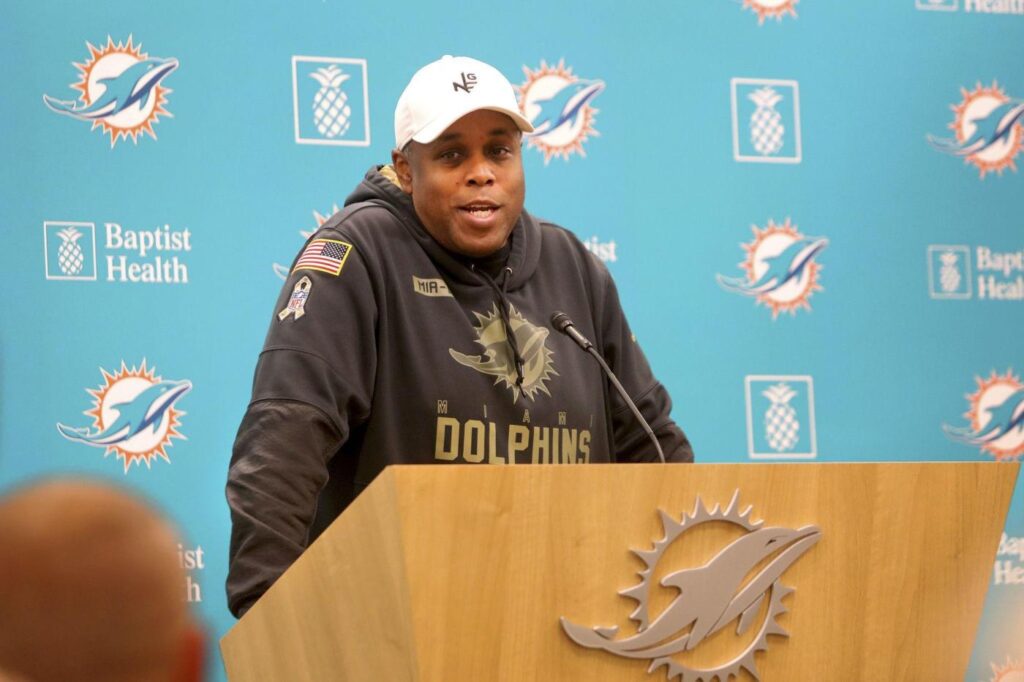
Ever go to the grocery store because that’s part of your normal routine, but as you walk the aisles you realize you don’t really need anything? You’ve got eggs and orange juice in the fridge, meat in the freezer, and bread and fruit on the counter.
That’s when you find yourself walking the aisles looking for a deal (maybe a buy one, get one free promotion), or trying to get creative with dinner recipes.
Picture Dolphins general manager Chris Grier as that aimless shopper during the 2022 NFL draft because that’s basically where Miami’s roster is heading into the summer.
Miami’s depth chart is pretty deep. I’m not saying the Dolphins roster is perfect, but there’s proven talent, and young developmental players at just about every position, in every unit.
For example, Tua Tagovailoa is one of the few young NFL quarterbacks with a winning record (13-8) early in his career. He’s still improving, and this new run-heavy, play-action based offense should cater to his strengths and mask his weaknesses.
But if he falters Teddy Bridgewater has proven he’s reliable NFL starter, and might be Miami’s best backup quarterback since Chad Pennington played behind Chad Henne.
Tyreek Hill is one of the NFL’s most dynamic receivers, and Jaylen Waddle set league records for rookie receivers last year. Behind them is a trio of youngsters in Cedrick Wilson, Preston Williams and Lynn Bowden Jr. who have talent and could blossom as they mature.
Mike Gesicki, Durham Smythe and Adam Shaheen set franchise records for tight end productivity two years ago, and could build on that success in this new offense. Then there’s Hunter Long, a third-round pick in 2021, who could develop in his second season.
At tailback Raheem Mostert, Chase Edmonds and Myles Gaskin are established NFL rushers who still have plenty to prove, and Salvon Ahmed has some upside.
The left side of the offensive line should be stabilized by the offseason signings of Terron Armstead and Connor Williams, and if Miami can’t find two capable starters on the right side out of Robert Hunt, Austin Jackson, Liam Eichenberg, Solomon Kindley and Greg Little, who were all early draft picks the past three seasons, an even greater problem (poor talent evaluation) exists.
On defense Jevon Holland and Brandon Jones have the potential to become one of the best safety duos in the NFL, and Eric Rowe is no slouch.
Xavien Howard and Byron Jones are one of the best cornerback duos in the NFL, and Nik Needham, Trill Williams and Noah Igbinoghene are talented youngsters who are growing into their roles.
Miami’s defensive line features five players — Emmanuel Ogbah, Christian Wilkins, Raekwon Davis, Zach Sieler and Adam Butler — who could be NFL starters on more than half of the league’s 32 teams, and young pass rushers like Jaelan Phillips, who set a franchise rookie record with 8.5 sacks in 2021, and Andrew Van Ginkel, who has registered 9.5 sacks and forced four fumbles the past two seasons, have plenty of room for growth.
From my viewpoint, there’s only two areas of the Dolphins roster that should be viewed as weaknesses, and that’s center and inside linebacker, which the Dolphin potentially addressed by selecting Georgia’s Channing Tindall with the 102nd pick in the third round.
In fairness to the Dolphins, Elandon Roberts is coming off a career-best season despite recovering from a season-ending anterior cruciate ligament injury the year before. And Duke Riley played well in his limited opportunity last season, and has started 27 NFL games in his six seasons. That’s why Tindall will likely begin his career as a role player and special teams contributor unless he proves he’s a quick learner and a coverage specialist.
As for center, Grier says teams have a higher opinion of center Michael Deiter than the Dolphins fan base and media, insisting that he gets calls from teams trying to trade for the former Wisconsin standout.
Deiter, who the Dolphins used a 2019 third-round pick to select, could still blossom into a solid NFL starting center, especially in this scheme. He comes from one of the best offensive line programs in college football, and has collectively started 23 games the past three seasons.
But he’s been average in his starts for Miami, and my biggest fear is he’ll bring down the effectiveness of the offensive line. And it could get worse if Deiter doesn’t stay healthy. The Dolphins had to use four centers through trades, practice squad promotions, waiver wire claims and roster poaching just to make it through the second half of last season.
Considering the roster lacks a backup for Deiter it would be irresponsible to conclude that spot isn’t a problem area, even if Miami’s plan is to convert someone like Kindley or Robert Jones to center, a transition Deiter experienced in his second season.
In past years I’d enter the draft obsessed about Miami filling this hole, or that hole, to make the Dolphins a more complete team. But the reality is this draft, with these few picks, likely won’t solve any of the roster’s problems.
And it doesn’t need to because adding a veteran free agents like J.C. Tretter, who is still available, could address the existing needs far better than a rookie from Wake Forest (Zach Tom) or Arizona State (Dohnovan West) ever could.
And that’s Miami’s biggest need heading into day three of the draft, which is a testament to the roster Grier and his staff have assembled the past four offseasons, one that seems pretty solid before September’s kickoff.
()
